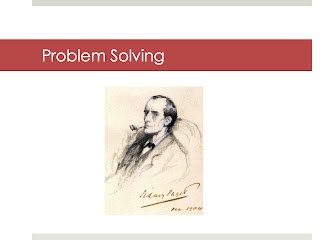In the next ten minutes, we are going to give an overview of how methodologies influence a practitioner's approach to their work. We have identified five key methodologies that can be employed within our own disciplines, and will show how these methodologies can function as a process, or device within the creative industries. Different projects need different approaches, utilising a combination of different methodologies at different stages of the process. There is no meta methodology to the order in which the points are being raised.
Talk through each bullet point.
Problem Solving - practical problem (ie how to fix something)
Focus / restriction – too many ideas, need to apply boundaries
providing alternatives – avoid being stuck in a rut
reviewing / reflection – the iterative reconsideration
critically contextualising - ?
Problem Solving
At the highest level, the goal of any creative task is to achieve or accomplish something. These tasks become a problem when any step involved in the achievement / accomplishment becomes difficult, doubtful, uncertain etc.
Problem solving methodologies can be employed to overcome these blocking issues.
Since each step in the creative process is likely to be inflicted with different blocking issues, different problem solving methodologies are required.
1 At the onset, deciding upon a direction may be a problem, and this can be solved by employing a brain-storming methodology.
2 Further into the process, the difficulty of practical implementation may be solved by employing a scientific methodology. Strictly speaking this is an iterative process in which the problem is stated, research is performed, a hypotheses is formulated and tested, and as a consequence either confirmed or reformulated. Although we are not engaged in scientific investigation this approach to problem solving is ingrained in western analytical thinking, and is implicit in most of the formal problem solving we do.
3 One of the most interesting problem solving methodologies comes for the world of literature and is attributed to the master detective: Mr Sherlock Holmes. His approach is a variant of the scientific methodology in which he advocates thinking, backwards, with an empty mind.
A visual representation of the process of 'thinking backwards' can be seen in Lina Peterson's work for the museumaker project.
We're looking at a piece from Lina's exhibition “Imagined Objects of Desire”, which formed part of museumaker project at the University of Nottingham Museum in 2010. Museumaker was a collaboration between the Arts Council, the Museums, Library and Archive Council, East Midlands and Renaissance East Midlands, with funding from the Arts Lottery and the Esmée Fairbairn Foundation. By showcasing contemporary craft at the very heart of regional museums, museumaker's aim was to develop new audiences and new understandings of both the craft work and the museum’s rich local collections”. Sir Christopher Frayling
Rather than looking forward, and using the museum exhibits as a starting point, Lina elected to start with the museum piece and work backwards. She looked at museum objects that had parts missing and chose to fill in the gaps – looking at what wasn't there.
In solving the problem of what response to make, Lina chose to look backwards. Using a 6th Century urn as inspiration, she chose to explore the decorative marks on the surface. Rather than exploring the marks and urn as a starting point, they were the destination, and instead Lina imagined what tool might have been used to make the mark.
And now I'll pass you over to Wendy ...
PS I've changed the banner background colour ... sorry, it's the artist in me! We need to make sure the fonts and slides all have the same format, so will check this when we meet tomorrow.



